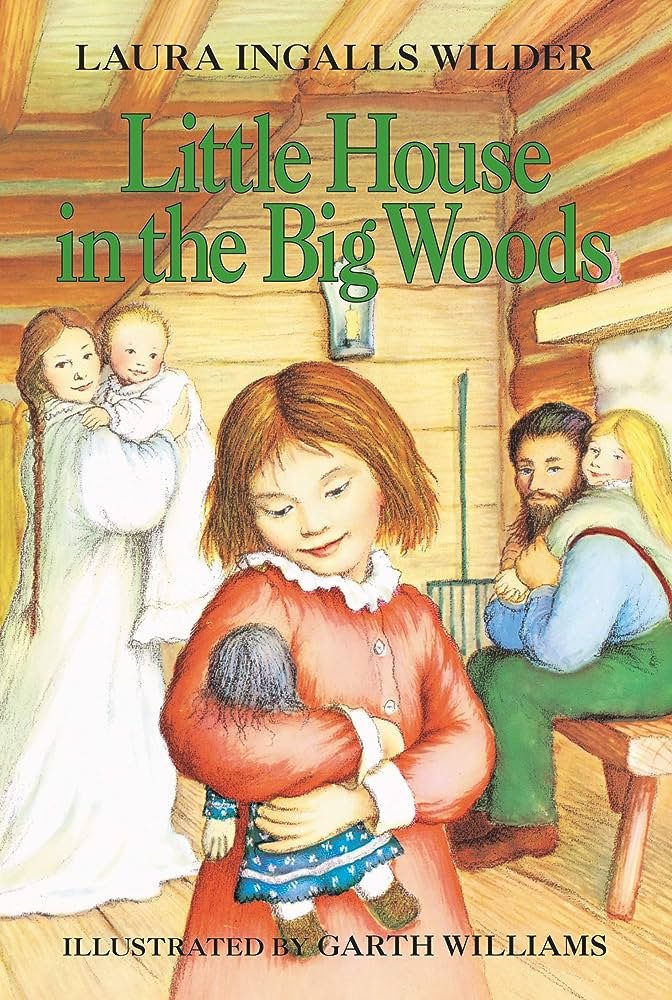Although I did not read a lot of historical fiction when I was a child, the Little House books were once series that I remember enjoying (although I was never a fan of the television series). I’m sure it has been almost twenty years since I read Laura Ingalls Wilder’s novels about life in the vast woods and prairies of Wisconsin, Kansas, Minnesota, South Dakota, and Missouri. I always knew the rough pioneer life wasn’t something that I was cut out for, but even so, I was fascinated by the descriptions of how the Ingalls family sustained themselves out in the wilderness – and always had plenty of good things to eat.
As I re-read Little House in the Big Woods, I found all the descriptions that had made such an impression on me when I was seven or eight years old: accounts of how Laura’s Pa had cured venison in a little smokehouse made out of a hollow tree, how Pa and Grandpa Ingalls had collected the sap from the maple trees and the family had made syrup and maple sugar candy, how Laura’s Ma made cheese and butter from their cow’s milk, and how Laura and her sister Mary would play up in the attic amongst all the piles of pumpkins and meats hanging from the rafters. (I must admit that I’m always drawn to descriptions of food, which abound in both the Little House books and the Redwall series by Brian Jaques.)
There were other scenes that I remembered as well – scenes that had to do with the family’s happy existence despite their isolation. Laura describes being cozy and snug in their little log cabin in the Big Woods of Wisconsin during the bitterly cold winters. With contentment, she describes how her father would tell them stories while they sat by the fire, then play them to sleep with his fiddle. The wolves were howling outside in the yard, but Laura knew she was safe with Jack the dog and her Pa with his gun to guard their family, and so she always fell asleep feeling warm and happy.
Apparently one editor turned away Wilder’s manuscripts because the stories don’t contain too much drama – even the tales of Ma, Pa, and Grandpa encountering dangerous wild animals somehow don’t feel threatening because Laura’s memories of early childhood are imbued with that feeling of safety. Despite the leisurely pace of the novels, however, I have found them equally engrossing at age seven and age twenty-seven. I think that the descriptions and stories appeal to me when I am in a certain mood because the labors and pleasures of the Ingalls family’s lives are so physical, tangible, and simple. After living in several different metropolitan areas and working very demanding jobs, I sometimes long for that kind of simplicity. She may have only been four or five years old when she was living in Wisconsin, but the beauty and the pleasure of so many aspects of life made a deep impression on her.
In contrast, there are a lot of problematic aspects of the Little House books that have been at the forefront of the recent literary discussions of Laura Ingalls Wilder, particularly her treatment of race. These conversations are important, both to have within literary communities and with our children as we read these books in contemporary times. Wilder portrays Native Americans and African Americans in extremely prejudicial terms. It’s jarring for contemporary readers to read some of the characters in various Little House books expressing different versions of the view “the only good Indian was a dead Indian,” especially paired with the many nostalgic elements in Wilder’s writing.
But I am not sure that I fully support the American Library Association’s 2018 decision to drop Wilder’s name from a prestigious children’s literature award, which they did to distance the prize from what the organization described as culturally insensitive portrayals in her books. I believe it is essential to acknowledge and discuss the fact that Wilder’s books are a product of her life experiences and her perspective as a settler in 1800s America. But also I believe we should not erase (or “cancel”) the books and historical sources that describe these attitudes. It’s important to continue to remember and discuss the fact that cultural attitudes of that time period were extremely different from our modern acceptance, understanding, and celebration of diverse communities. As the well-known adage states, those who forget history are doomed to repeat it. (Given the racial violence against various ethnic communities that has seemed to grow again in recent years, it’s important to use these discussions to examine current racial tensions as well.)
Despite the upsetting depictions of race in the Little House novels, I still really enjoy Little House in the Big Woods, Little House on the Prairie, and the rest of the series. Because she was such a content child and was able to convey that effectively as an adult author, when I read Little House in the Big Woods, I feel happy and content as well. Perhaps I should be hesitant to admit that I love Wilder’s novels, but I am not alone. Wilder’s books are still beloved among many generations, although it remains to be seen if generations of the future will appreciate the Little House series.
I hate to use the phrase “heart-warming,” but this is one of those novels that can actually make you feel as though you’re snuggled down under the covers near a blazing fire on a cold winter evening, and someone is playing you to sleep. Five stars for a novel that can make me forget the fast pace of daily life, at least for a little while.



This website was created with a lot of love, Coke Zero, and tacos by Kumquat Creative.